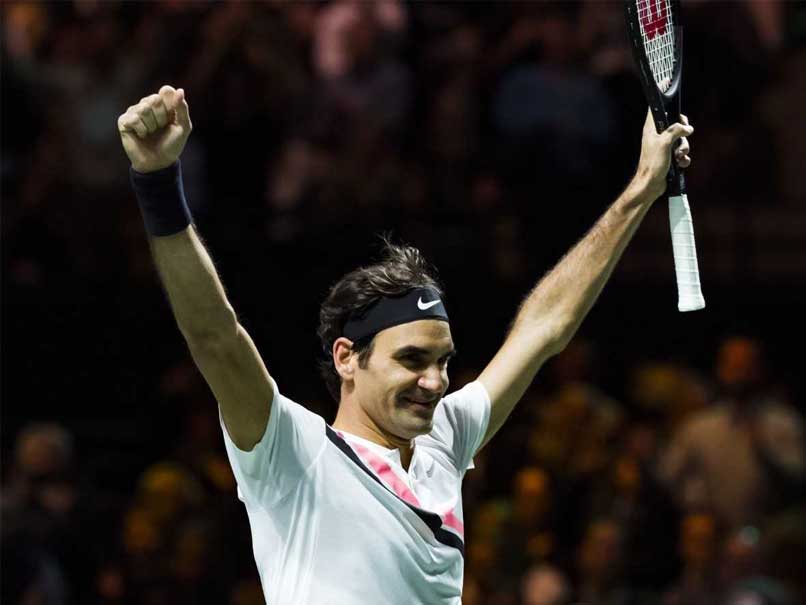For more than four years, an avalanche of injuries, fierce rivals and the first extended absence of his career kept Roger Federer from the sport's high point.
Two weeks after re-summiting the Everest of tennis, Federer - at 36 1/2 the oldest man or woman to rank No. 1 - is charting another unprecedented expedition in rarefied air. How long can he carry on at this level?
"The air is thin up there," said Federer of his age-defying success. "We don't know."
What we do know is that the Swiss maestro's first test comes this week at the BNP Paribas Open in Indian Wells, California. A five-time winner and last year's champion, Federer will relinquish the top ranking to No. 2 Rafael Nadal if he fails to reach the semifinals.
For Federer, the thrill of trailblazing, even in his mid-30s, keeps him going. Pushing limits, surprising himself, bending historic bounds of success are part of the fun.
"It's interesting to myself," Federer said Monday over a cappuccino (with regular milk) a few hours before a charity exhibition here that featured Microsoft billionaire Bill Gates. Two weeks had passed since Federer regained the top ranking Feb. 19 after winning his second title of 2018 at Rotterdam.
Federer is aware of team-sport athletes such as Tom Brady, 40,who are pushing past the expected frontiers of decline. He cited NHL standouts Jaromir Jagr, who played this season in his mid-40s, and Chris Chelios, who retired at age 48, as other prime examples.
But tennis, he noted, is an individual sport. Few men have dominated over 30.
Ken Rosewall remains the oldest Grand Slam champion at 37 when he captured the 1972 Australian Open in an era when many top players didn't make the trek to Australia to compete. Andre Agassi's late-career revival earned him the No. 1 ranking at age 33. Jimmy Connors memorably reached the 1991 U.S. Open semifinals at age 39.
"It's not frequent," said Federer, a father of four. "You sort of take it - I don't want to say a tournament at a time - but like one year at a time instead of thinking, 'OK, Tokyo Olympics here I come.' The way hasn't been paved for you."
Federer, the ATP's all-time leader in weeks at No. 1 (306 as of March 12) trusted that he could win big titles again, though two years ago another climb to the top seemed far-fetched.
"That, to me, was not realistic at the time," he said.
But once it came back into play after he defended his title at this year's Australian Open, Federer altered his schedule to chase the No. 1 ranking in Rotterdam. It was his most satisfying trip to the peak.
"For me it was like coming full circle with my team, with my fans, with everybody," he said.
Federer expects to play another year, likely two, but won't look beyond that. His health and family come first.
That plan looked shaky before his autumnal surge.
From late 2012 to the end of 2016, Federer failed to win a Grand Slam title - the longest drought since his first major title in 2003. He took an extended break the second half of 2016 to rest his surgically repaired left knee, which he had injured while bathing his twin daughters. He went titleless that same year and fell outside the top 10 for first time in a decade, slipping to No. 17.
With the support of his coaches Ivan Ljubicic and Severin Luthi, and his longtime physical therapist Pierre Paganini, Federer never veered from his course or contemplated retirement. He reflected on the overall picture, "but not like a panic," he said.
"It was never - 'What do you guys think? Is this over?' I never had that. I felt I was too close to winning. I was too close to the top. I was too close to still beating the best."
Since returning at the 2017 Australian Open, Federer is 64-5 with nine ATP titles. He added three Grand Slam crowns in the past 15 months - back-to-back wins in Melbourne and his record eighth Wimbledon last July.
Federer credits his fluid, efficient style of play, along with his team's obsessive planning for his continued success, even as it gets harder to make quick adjustments like he did at Rotterdam last month. He's also cut back his practice time, preferring quality over quantity. "It's a well-oiled machine," he said.
Don't discount love of the game, either, said Swiss Davis Cup captain Luthi, who has known his countryman since he was 13 years old. "For me it's surprising how much passion he still has," Luthi said.
While the demographics of tennis have been trending older, younger rivals such as Nadal, Novak Djokovic and Andy Murray - all of whom have spent time at No. 1 in recent years - have been hobbled or sidelined as they've approached or passed their third decade. Only 12-time major winner Djokovic, 30, is entered at Indian Wells.
And though he keeps moving the goal line of all-time major titles - Federer owns 20, Nadal is second with 16 - he doesn't feel his lead is safe.
"No, not at all," he said. "I just feel like today we're all so good on clay, grass, and hard courts, if you get on a roll you can rack up some titles. It's not as safe as it was in, say, the 1980s."
Federer's 2018 statistics support the perception he is playing better than ever - or at least as well as when he ruled the sport a decade ago.
After a 12-0 start, his winning percentage on first-serve points (82 percent), second serve points (63 percent), and service games won (95 percent) are all at career highs.
Jack Sock, the top-ranked American at No. 10, said Federer uses his speed, experience and accuracy to smothering effect, while rarely failing to protect his own serve.
"He's not human," said Sock, who has yet to take a set off Federer in four meetings.
Sock, 25, said Federer's example has stretched the notion of career trajectory for a whole generation of players. "Now when you're 30, 31, you can say, 'Maybe I have some of my best tennis ahead of me,' " he said.
Despite innumerable records, the most lasting impression Federer could leave tennis is sustained excellence.
Consider that the 14-plus years between when he first rose to No. 1 and his most recent stint is the biggest gap in history. The five-plus years between his most recent stay at No. 1 in 2012 is also the longest lull.
Longevity is something he'll be "very proud of" when he retires, Federer said. Especially because he was a hotheaded junior and inconsistent young professional. He wondered if he would harness his talent.
"I always thought it was going to be hard for me to achieve that because I was up and down," he said. "From 17 to 22, it was tough for me to stay focused on a daily basis."
With his resurgence, two seemingly untouchable men's marks - Connors's 1,256 match wins and 109 titles - are within striking distance. Federer owns 1,144 match victories and 97 titles.
Federer, typically, is not aiming for those milestones. He can't think that far ahead. But if his body holds up and he plays at two or three more years, both are achievable.
Meantime, triple-digit tournament wins is in his crosshairs.
"I just think it would be so cool to get to 100 titles," he said. "I never thought that was something I could do."
And why not? Even in thin air, Federer keeps breathing easy as he pioneers new paths of possible.

